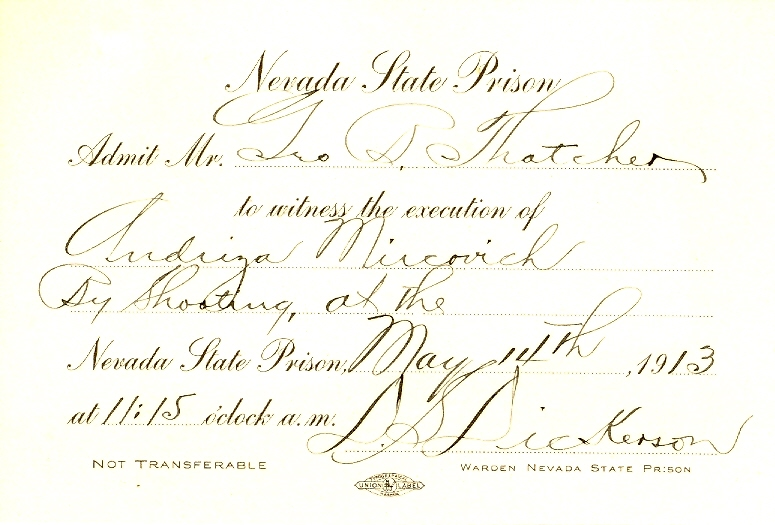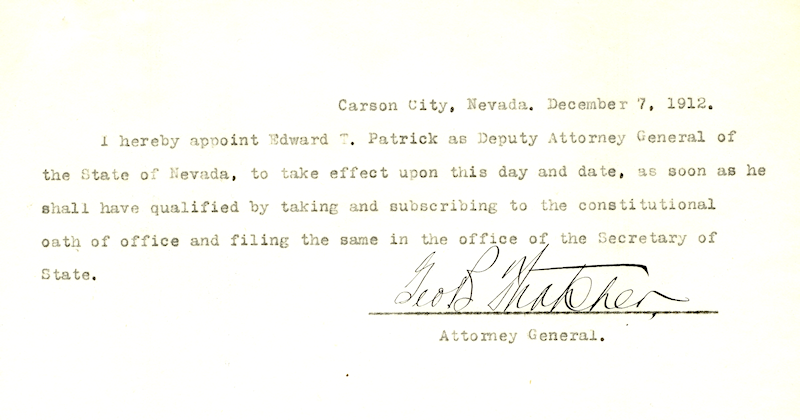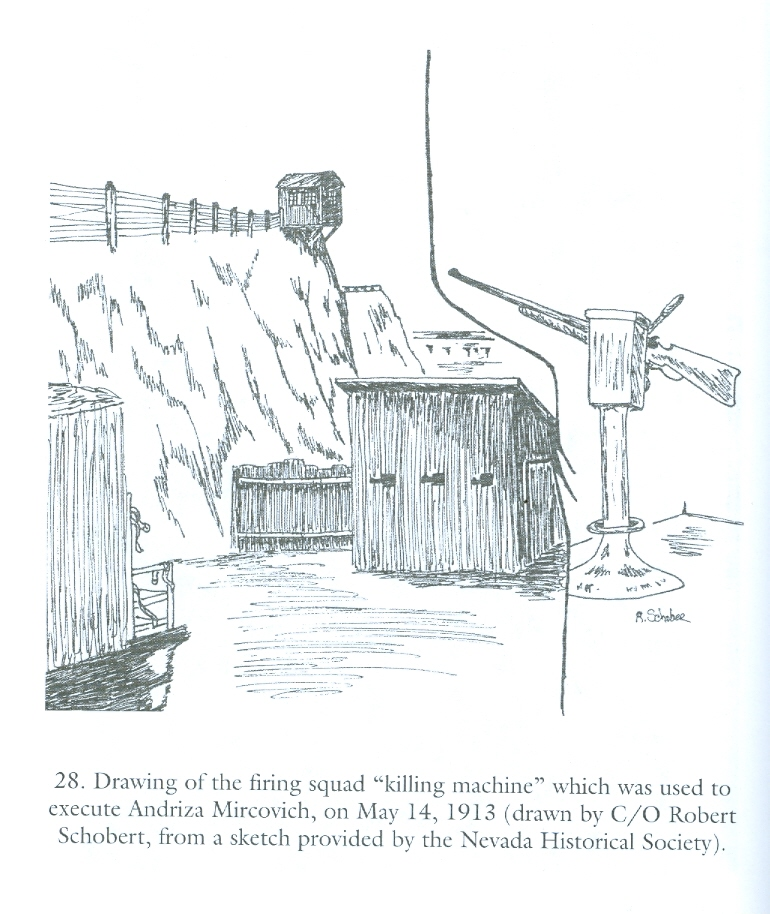16th Nevada Attorney General
Term 1: December 5, 1912-January 4, 1915 (Appointed)
Term 2: January 4, 1915-January 6, 1919 (Elected)
Biography
George Bayard Thatcher, the son of George W. Thatcher and Mary E. (Madigan) Thatcher, was born on July 28, 1882, in Denver, Colorado. After graduating from the University of Colorado law school in 1904, Thatcher moved to Tonopah, Nevada, where he opened a law practice.
While in private law practice in Tonopah, the Nye County District Court, on May 14, 1912, appointed Thatcher to represent Andriza (Andrew) Mircovich for the premeditated, stabbing murder of John Gregorovich, the executor of Mircovich's cousin's estate. Mircovich, convicted on June 12, 1912, of the murder, was sentenced to death.

Source: Nevada State Library and Archives, Carson City, Nevada
A new 1911 state statute allowed Mircovich to choose between being hanged or shot by a firing squad. He chose to be shot. Ironically, Attorney General Thatcher was invited to witness the execution of his former client, Mircovich. Thatcher's invitation is marked "Not Transferable".

Source: Nevada State Library and Archives, Carson City, Nevada
Mircovich was the first and only Nevada state prisoner executed by Nevada's infamous "shooting machine" on May 14, 1913.
[1]
Acting Lieutenant Governor Gilbert Ross appointed Thatcher as Nevada's 16th Attorney General on December 6, 1912, to fill the unexpired term of Cleveland H. Baker, who died in office on December 5, 1912.
After Thatcher's appointment as Attorney General, memories of the recent death of Attorney General Baker caused some public consternation. From the San Francisco Call, Volume 113, Number 25, 25 December 1912:
ILLNESS OF OFFICIAL CAUSE OF SENSATION
Report of Attorney General Dying Creates Alarm in Sagebrush State
RENO Nev. Dec. 24 - Following closely on the death of his predecessor, the report that Attorney General George B. Thatcher was dying in his home in Tonopah caused a sensation in the state today, but investigation disclosed the fart [sic] that while Thatcher was seriously ill, he is now recovering from a threatened attack of pneumonia. This afternoon Deputy Attorney General Patrick received word from the attorney general's secretary, Price, that the sick man was getting better. On the previous night Patrick received a message that Thatcher was threatened with pneumonia, his temperature rising to 103. The attorney general expects to remove his residence to Carson City January 1, 1913.
Incumbent Thatcher later ran for a regular term as Nevada Attorney General in the November 3, 1914, general election.
After leaving the Nevada Attorney General's Office, Thatcher also is noted for being a prominent divorce attorney in the divorce capital of the United States-Reno, Nevada-during the late 1920's and through the 1930's. Thatcher's clients included Hollywood sensation Carole Lombard in her 1933 divorce from Hollywood actor William Powell (Lombard then went on to marry Clark Gable). Thatcher also represented Woolworth Dime Stores' heiress Barbara Hutton in her 1935 divorce from Alexis Mdivani.
Thatcher continued his practice of law in Reno, Nevada, until his death on October 15, 1946, in San Francisco, California. From Thatcher's obituary in the Nevada State Journal Oct 16, 1946, page 14, it was reported that "[b]esides his wife, who was at his bedside when death came, he leaves a son, John P. Thatcher, a Reno attorney who recently returned from the armed services, and a daughter, Mrs. Dennis Houge of Boise, Idaho. He leaves six grandchildren."
Election of 1914
Elected as Nevada's 19th Attorney General on November 3, 1914, Thatcher (Democrat) received 9,940 (49.3%) of the 20,164 votes cast; George Springmeyer (Progressive) received 6,017 (29.8%) votes; and Richard A. McKay (Republican) received 4,207 (20.9%) votes.
[2]
Office Administration and Duties
During this term, Thatcher had one Deputy Attorney General, E.T. Patrick, and a stenographer.

Source: Nevada State Library and Archives, Carson City, Nevada.
Budgets for the Nevada Attorney General's Office for the 1913-1915, 1915-1917, and 1917-1919 state biennial fiscal periods were as follows:
1913 -1915
|
$11,650
|
|
|
$4,000
|
Attorney General's Salary
|
|
|
$4,800
|
Deputy Attorney General's Salary
|
|
|
$2,400
|
Typist Salary
|
|
|
$ 450
|
Steel Filing Cases
|
|
|
|
For current expenses for telegraph, postal and contingent expenses for the State officers, Supreme Court, and State Library, and for transportation of State property, $10, 000
|
|
|
|
For salary of the Attorney General as ex officio Mineral Land Commissioner, $5,000
|
|
1915 - 1917
|
$19,400
|
|
$7,200
|
Attorney General's Salary
|
|
$2,800
|
For salary of the Attorney General as ex officio Mineral Land Commissioner
|
|
$4,800
|
Deputy Attorney General's Salary
|
|
$2,400
|
Typist Salary
|
|
$1,200
|
Actual traveling expenses of the Attorney General
|
|
$1,000
|
For contingent expenses of the Attorney General
|
1917 - 1919
|
$19,850
|
|
$7,200
|
Attorney General's Salary
|
|
$2,800
|
For salary of the Attorney General as ex officio Mineral Land Commissioner
|
|
$4,800
|
Deputy Attorney General's Salary
|
|
$2,400
|
Stenographer Salary
|
|
$450
|
Additional clerk and stenographic assistance; January 1 to April 1, 1917.
|
|
$1,200
|
Actual traveling expenses of the Attorney General
|
|
$1,000
|
For contingent expenses of the Attorney General
|
|
|
For enforcement of 1917 Statutes of Nevada, Chapter 49, Pages 51-52, $1,000
|
|
|
To carry out 1917 Statutes of Nevada, Chapter 143, Section 1, Pages 241, $75
|
|
|
|
|
|
|
The 1913 Nevada State Legislature added the following duties for the Attorney General:
- The Nevada Attorney General is to be a member of the State Investment Board (Statutes of Nevada 1913, Chapter 167, page 252).
- The Nevada Attorney General is ". . . authorized, empowered, and directed to institute and prosecute a through investigation of all the affairs of the State Bank and Trust Company and of the receivership thereof . . ." (Statutes of Nevada 1913, Chapter 204, page 279).
The 1915 Nevada State Legislature added these duties for the Attorney General:
- The Attorney General is to prosecute lawsuits against insurance companies in the behalf of the Nevada State Controller acting in his capacity as ex officio State Insurance Commissioner (Statutes of Nevada 1915, Chapter 99, Section 10, page 118).
- The Attorney General ". . . is hereby authorized to direct, to prepare, or have prepared under his supervision, a schedule showing the changes in the Revised Laws of Nevada 1912 . . . and have same printed in suitable form, and to distribute the same gratuitously to all proper applicants thereof . . ." (Statutes of Nevada 1915, Chapter 103, Section 1, pages 122-123).
- The Attorney General ". . . is hereby authorized to commence, maintain, or defend, in the Supreme Court of the United States, or any court having jurisdiction of the action, in the name of the State of Nevada . . . for the purpose of establishing and determining the rights of the State of Nevada . . . in and to the waters of all interstate streams located partly in the State of Nevada, where such waters, or part thereof, are claimed by any other state . . ." (Statutes of Nevada 1915, Chapter 138, Sections 1 & 2, pages 159 - 160).
- The Attorney General shall defend lawsuits against the Nevada Tax Commission (Statutes of Nevada 1915, Chapter 153, Section 10, page 185).
- The Attorney General is to provide legal services to the State Water Engineer and defend the State Water Engineer and the State of Nevada against lawsuits (Statutes of Nevada 1915, Chapter 253, pages 378 - 386).
- The filing date for the District Attorney Reports to the Nevada Attorney General was changed to twice a year; the fourth Monday of March and forth Monday of August of each year (Statutes of Nevada 1915, Chapter 255, Section 1, page 387) These District Attorney Reports had been due once a year, of December 1 (Statutes of Nevada 1889, Chapter LIV, pages 54-55).
The 1917 Nevada State Legislature added these duties:
- The Attorney General (along with the District Attorneys) is to enforce a state statue prohibiting a female employee to work not more than eight hours in a 24-hour period or 56-hours a week (perishable food worker, nurses, and nurses in training exempted). Also, the employer is to provide "suitable seats" to allow the female employees to sit whenever possible (Statutes of Nevada 1917, Chapter 14, Section 3, page 17).
- The Attorney General ". . . is authorized, empowered, and directed . . . (to take legal action) . . . to prevent or restrain the pollution of any public stream or streams in the State of Nevada . . ." (1917 Statutes of Nevada, Chapter 49, Section 2, page 51). The Attorney General is to be a member of an advisory board committee to carry out this act (Statutes of Nevada 1917, Chapter 49, Section 5, page 52).
- The Attorney General ". . . is hereby authorized to directed to prepare, or have prepared under his supervision, a schedule showing the changes in the Revised Laws of Nevada 1912 . . . and have same printed in suitable form, and to distribute the same gratuitously to all proper applicants thereof . . . " (Statutes of Nevada 1917, Chapter 143, Section 1, pages 241).
- The Nevada State Board of Investments was created with the Attorney General as a member thereof and to provide legal advice (Statutes of Nevada 1917, Chapter 212, Section 2, pages 399-400).
[1]
It was an ordinary murder, by an ordinary man: his cousin died in a mining fire in 1911, and
Andriza (or Andrija) Mircovich
, feeling he got stiffed on the resulting inheritance, stabbed to death the probate attorney (a fellow South Slav named Gregorovich).
The execution, however, was extraordinary - and has never in history been repeated.
The march of science had lately made possible whole new methods of execution heretofore uncontemplated - like
electricity
and
poison gas
. At the same time, mechanical engineering had improved old standbys like beheading and
hanging
from slipshod, error-prone affairs to efficient operations worthy of an age of industry.
Somewhere between those categories lies the firing squad. Firearms, of course, were a new technology relative to the noose and a big ol' axe, but we do find executions by shooting
back to the 17th century
at least.
Though the guns themselves had been updated, Nevada was forced by circumstances to do for firing squads what Dr. Guillotin had done for headsmen.
Nevada law at the time allowed inmates to choose between hanging and shooting. The state had all the accoutrement for the former, but it hadn't ever conducted one of the latter. When Mircovich insisted on being shot, and prison offices couldn't find people willing to pull the trigger, Nevada actually built a "shooting gallery of steel"-an entire contraption to automate the lethal fusillade.

Nevada got rid of this inconvenient execution option [in 1921], and Mircovich remains the only human being put to death by shooting (whether by human hands or mechanical ones) in the Silver State's history. The guns from this weird artifact currently reside at the
Nevada State Museum, Carson City
; the scaffolding that once surrounded them is in some aircraft carrier or tank, having been donated as scrap metal during World War II. Nevada State Library and Archives, Carson City, Nevada
[2]
Political History of Nevada
, 2006, p. 371.